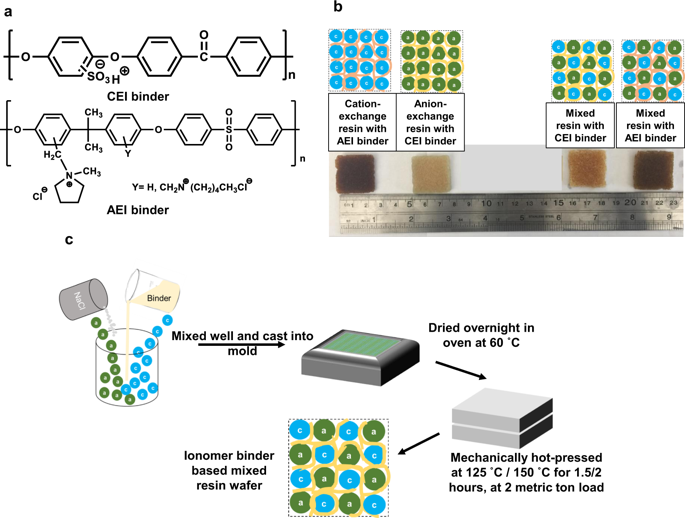npj Clean Water ( IF 10.4 ) Pub Date : 2020-03-02 , DOI: 10.1038/s41545-020-0052-z Varada Menon Palakkal , Lauren Valentino , Qi Lei , Subarna Kole , Yupo J. Lin , Christopher G. Arges

|
Electrodeionization (EDI) is an electrically driven separations technology that employs ion-exchange membranes and resin particles. Deionization occurs under the influence of an applied electric field, facilitating continuous regeneration of the resins and supplementing ionic conductivity. While EDI is commercially used for ultrapure water production, material innovation is required for improving desalination performance and energy efficiency for treating alternative water supplies. This work reports a new class of ion-exchange resin-wafers (RWs) fabricated with ion-conductive binders that exhibit exceptional ionic conductivities—a 3–5-fold improvement over conventional RWs that contain a non-ionic polyethylene binder. Incorporation into an EDI stack (RW-EDI) resulted in an increased desalination rate and reduced energy expenditure compared to the conventional RWs. The water-splitting phenomenon was also investigated in the RW in an external experimental setup in this work. Overall, this work demonstrates that ohmic resistances can be substantially curtailed with ionomer binder RWs at dilute salt concentrations.
中文翻译:

借助将离子交换树脂颗粒固定到多孔晶片基板中的导电离聚物粘合剂促进电去离子
电去离子(EDI)是一种采用离子交换膜和树脂颗粒的电动分离技术。去离子作用在施加的电场的影响下发生,从而促进了树脂的连续再生并补充了离子电导率。尽管EDI在商业上用于超纯水生产,但仍需要进行材料创新,以提高淡化性能和能效,以处理替代水。这项工作报告了用离子导电粘合剂制造的新型离子交换树脂晶片(RW),它们具有出色的离子电导率,比包含非离子聚乙烯粘合剂的常规RW膜提高了3-5倍。与常规RW相比,将其合并到EDI堆栈(RW-EDI)中可提高脱盐率并减少能耗。在这项工作的外部实验装置中,也对RW中的水分解现象进行了研究。总的来说,这项工作表明,在稀盐浓度下,离聚物粘合剂RW可以大大降低欧姆电阻。











































 京公网安备 11010802027423号
京公网安备 11010802027423号